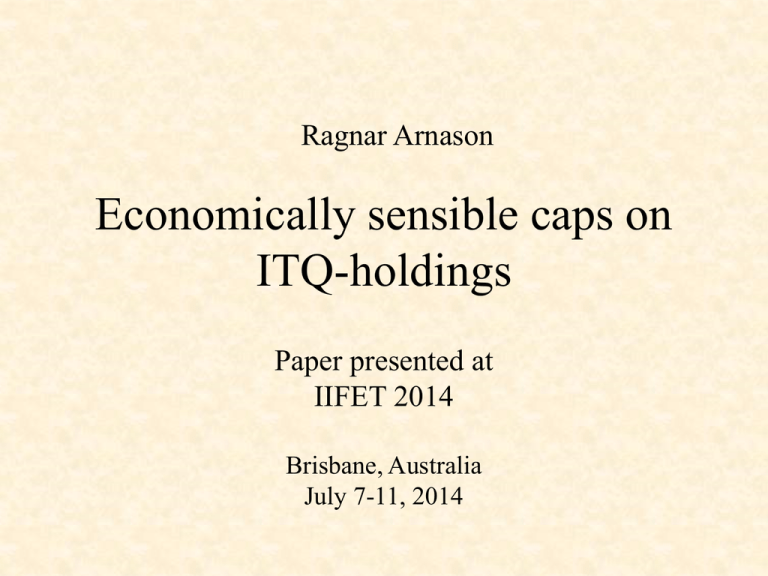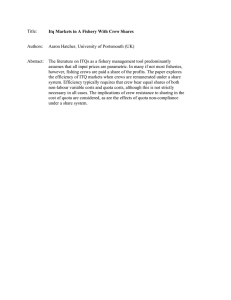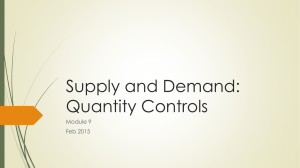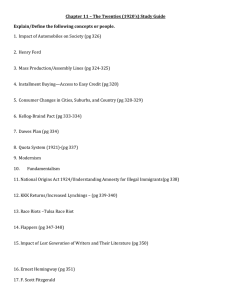Economically sensible caps on ITQ-holdings Ragnar Arnason Paper presented at
advertisement

Ragnar Arnason Economically sensible caps on ITQ-holdings Paper presented at IIFET 2014 Brisbane, Australia July 7-11, 2014 Introduction • Caps (upper limits) on ITQ-share holdings are imposed in many ITQ fisheries – E.g. Canada, Iceland, New-Zealand, Chile & Norway • Reducing caps further or imposing them in other ITQfisheries is being considered – E.g. Iceland & USA • Potentially a significant economic impact => important to study the associated economics Rationale for caps (as far as I can see) 1. To prevent monopolistic behaviour in – output markets (fish) – input markets (labour etc.) – ITQ markets (quotas) 2. To limit size, profits of fishing companies (Reason unclear; Politics; limit socio-political power of fishing companies; general dislike of big business and ITQs; envy?) Here only consider only rationale #1 The setting 1. A fishery managed by ITQs – – – Authorities set TACs: Q Firms hold/buy quotas: q(i) Harvests cannot exceed quotas; h(i) q(i) ITQ rental price: s. Note s(Q; x,p) 2. Fishery profit functions: (h(i),x,p;i)-sh(i), i=1,2,…I h(i): harvest x: biomass p: vector of input and output prices Monopolistic behaviour Alter prices by limiting quantity (or vice versa) Note: Both output and input (monopsony) prices Under ITQs a firm will only affect prices by withholding quota from fishing! The other method, throwing fish away, is less economical Notation Withheld quota: (0) Firm’s actual harvest: q- (0) Total harvest: H=Q- Input and output prices: p(Q-) Quota prices: s(Q-)* * Quota rental price depends on marginal profits of harvest which falls with the harvest volume. The firm’s maximization problem: Max q , r t ( q , x , p ( Q ); i ) s ( Q ) q e dt 0 s.t. x G ( x) Q q-0, 0, Basic necessary condition for withholding quota: H Shadow value of biomass to fisher i p pH h (i ) sH q (i ) 0 0 Simplifying observations S-1 p h(i) [Output price; Hotelling’s lemma] S-2 w z(i) [Input prices; Hotelling’s lemma] S-3 h (i ) s [Quota rental price; Property of ITQ-system] S-4 pH E ( p , H ) S-5 q(i)=h(i) p w s , wH E ( w, H ) , sH E ( s, H ) H H H S-6 (i) hH(i) s [definition of elasticities] [Evaluated at =0] [Property of ITQ systems if TAC is optimal] Necessary condition for withholding quota, >0 q(i ) 1 (i ) Q 1 E ( s, H ) (i ) E ( w, H ) E ( p, H ) p s Cost-revenue ratio Inferences • The (numerically) higher the elasticity of output and input prices with respect to harvest, the lower is the critical size of the firm. • The (numerically) higher is the elasticity of the quota rental price with respect to harvest the higher is the critical size of the firm. – The quota is valuable => withholding it is costly • The higher the p/s ratio, i.e. the lower the marginal profits of fishing, the lower is the critical size of the firm. A numerical example Reasonable values for the parameters Parameter Assumed Comments values E(p,H) -0.5 This is equivalent to E(H,p)= -2 E(w,H) 0.2 E(s,H) -1 p/s 2 0.5 Note that 1- = profits/revenues Critical size ˆ 0.83 Sensitivity analysis for ̂ 1.8 1.6 Critical 1.4 1.2 1 E(s,H) E(w,H) 0.8 E(p,H) 0.6 p/s 0.4 0.2 0 -50% -25% 0% 25% Deviations from basic assumptions 50% Conclusions 1 Having market power in an ITQ fishery does not imply it is profitable for the firm to use this market power. – The reason is the E(s,H) – Basically the benefits must exceed the price of quota – This is different from normal monopolies Not sufficient to merely study market power to set sensible size caps! Conclusions 2 The critical size of firms (i.e. before withholding quota becomes profitable) is a complicated function – Involves several elasticities and quantities To determine a sensible cap on firm ITQholdings is a complicated empirical exercise Conclusions 3 The empirical quantities determining the critical firm size evolve over time Need to update studies (and rules) frequently Conclusions 4 When is it beneficial to impose caps on ITQ-holdings? 1. Firms exceed the critical size 2. Social costs of larger firms (monopoly costs) exceed social benefits (efficiency gains) 3. Enforcement costs are less than the benefits of enforcement So, even if ˆ 1 , it is not necessarily a good idea to impose a cap on ITQ-share holdings! END The critical firm size (If (i)> ˆ (i ) withhold quota) ˆ (i ) 1 p 1 E ( s, H ) (i ) E ( w, H ) E ( p, H ) s Cost-revenue ratio Note that 1. E(s,H)<0 increases (i) 2. (i)E(s,H)-E(s,H)>0 decreases (i)



